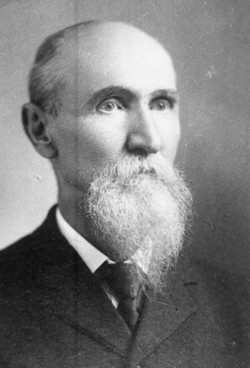
William Robertson Rankin (1842-1913) and
Margaret Jane "Maggie" Ramsay (1841-1923)
South Carolina to Calhoun, Georgia
Copyright July 2010 by Linda Sparks Starr

William Robertson Rankin, about 1896
" I got off the train in Calhoun without a cent. I did without breakfast because I wouldn't beg. Before dinner I got acquainted with a school trustee who invited me to his home for dinner and supper. I asked for the place as school principal, borrowed money to go back to South Carolina for references and six months later, borrowed money to go back for my wife. Right there in Calhoun I've been ever since. I call myself the pioneer tramp and if a tramp ever comes to town and asks for breakfast, he gets the same breakfast that I have." [Reeve p. 21 citing speech to the legislators in Atlanta]
William Robertson Rankin, born 18 December 1842 near Slabtown, South Carolina, was the eldest son of Thomas F. and Sarah Ann (Orr). He undoubtedly was named for his paternal uncle (born 1809) who perhaps had recently died. The name perhaps originated to honor William Rankin (1748-1817) and his wife Lettice Robertson. They took in the orphaned nine-year-old grandfather of this subject and raised him as their own. Or perhaps the name originates in the background of W. R.’s grandmother, Mary (Rankin,) whose father is referred to herein as James the Enigma.
Both of W. R.’s parents were the eldest in their families making W. R. among the oldest of grandchildren on either side. The Rankin grandparents are thought to have lived within easy walking distance, giving "grandpa George and grandma Polly" ample opportunity to pass along the tales of bygone years. W. R. was twelve when his grandfather died, thus old enough to understand and remember the family connections. A clue he did so is found years later when family members referred all seeking knowledge of this family’s history to W. R.
Quoting the sketch of W. R. published in one of the Georgia papers: "His father was not possessed of an abundance of this world’s goods and as there were other mouths to fill young Rankin found that if he ever had an education he must get it himself. He was ambitious to obtain knowledge and willing to undergo any kind of hardship and privation to accomplish his purpose. His early training was at the district school to which he walked a distance of three miles, but he learned rapidly and was at last enabled to take a course at the Thalian Academy under that able and conscientious instructor, Rev. John L. Kennedy ... " Thalian Academy was founded in 1832. The listing of courses undertaken by W. R. seems equivalent to that of a prep school for Ivy League Colleges: "regular course of Latin & Greek ... French, geometry, Algebra, Rhetoric ..." Wigington described the Slab Town campus as one main building consisting of a large classroom with several smaller rooms along the side. These were used for study and perhaps small group recitation. She explained cabins were erected near the main building to accommodate those students who lived too far to commute. Classes began at eight o’clock in the morning and ended at five o’clock in the afternoon. There was a break for lunch at midday with two shorter recesses. The school ended around the time W. R. completed his studies.
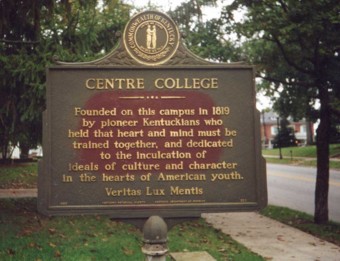
From Thalian Academy W. R. went on to Centre College in Danville, Kentucky. Although W. R. is not listed as a student in the 1860 catalogue, a staff member of the Special Collections department of Grace Doherty Library explained the absence of his name may be explained by his enrollment after the publication deadline. The librarian said each student of that time followed "a classical curriculum with a very rigid sequence of studies." Additionally he provided a copy of the pages from the 1861 catalogue listing W. R. as a member of the sophomore class along with each year’s required courses. Just to be admitted to Centre College required a course of studies that would make most of today’s college graduates blanch. Courses
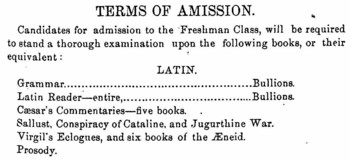
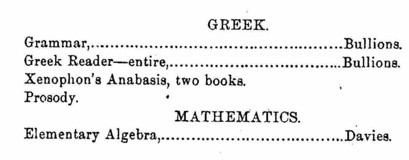
Three weeks after the secession of South Carolina from the Union, W. R. was honorably dismissed from Centre College in accordance with his own request.
Presumably before the end of January 1861 W. R. was back on his native soil, excitedly following the news of the birth of the Confederacy. In May he joined Hampton’s Legion and headed north into Virginia with high hopes of victory before the end of summer. After the dissolution of the Legion summer 1862, W. R. joined his brother’s company within the South Carolina Palmetto Sharpshooters, Longstreet’s Corps of Lee’s Army of Northern Virginia. As such W. R. was in all the major battles except Gettsyburg. However, while his not-so-fortunate comrades recuperated from that disaster, his unit was detached and he saw action in Georgia and Tennessee. He rejoined the Army of Northern Virginia in time to participate in the long withdrawal to the lines around Petersburg. His experiences, detailed in the diary he kept for almost two years, are told in W. R. Rankin: Manassas to Appomattox so won’t be repeated here. [Please click here for the form to order the book.]
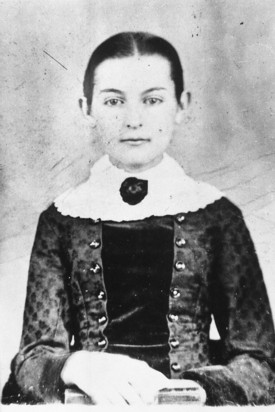
Margaret Jane Ramsay, probably about age twelve.
An unresolved question is where and when did W. R. and his future wife, Maggie Ramsay, meet? Maggie lived in a house on a bluff overlooking the Tugaloo River in now Oconee County, South Carolina, just across the river from Habersham County, Georgia.
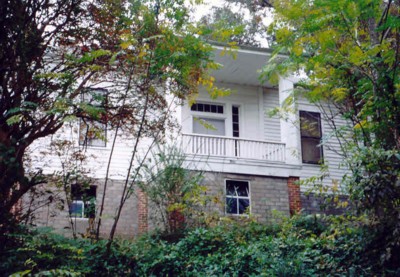
The Ramsay house, Oconee County, South Carolina
Many miles lay between their homes and no prior connections between their two families have been found. Nothing in the RAMSAY tradition suggests Maggie or any of her siblings attended Thalian Academy. Since no RAMSAY appears in the list of solders in the SC Palmetto Sharpshooters we can reasonably rule out W. R. becoming friends with one of her brothers during their service. In the South after the war, large gatherings of friends and neighbors were a thing of the past. Yet, Ramsay cousin, L. D. Chandler, said they met at a party. Although the two could have met at a large political gathering in the period between late January and May 1861 when W. R. was between Centre College and Hampton Legion, it seems more likely they met after the war. According to the sketch on W. R.: "After the war he returned to his home in South Carolina ... he drifted to Habersham county and engaged in teaching. When his school was out he concluded to move further and after visiting several other places located at Calhoun in 1867. He was at once elected principal of the Calhoun High School which he managed with the best results for two years." This is the only source for his spending time in Habersham County; otherwise, it differs only slightly from other statements made by W. R. himself.
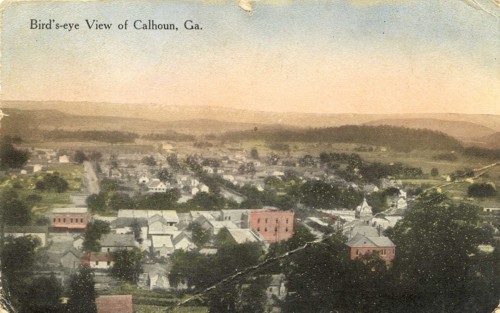
This post card has on the reverse side "Sold by Rankin Book Store"
According to Ann Jones, when asked why he settled in Calhoun, W. R. replied that when he got on the train, he handed the conductor all the money he had and received a ticket to Calhoun, so he got off there and settled in. [letter dated 31 Dec 1987] His granddaughter Alice (Starr) Schisler explained "Calhoun was the place to be right then. It was rebuilding after the war and exciting things were happening there." Something more may have been going on though. In November 1870 Maggie purchased four one-acre-lots in Calhoun from her brother Andrew H. Ramsay. How and when Andrew acquired Lots 62, 65, 66 and 61 in the Chandler Survey is not known, but presumably was after 1865. [Ramsay p. 28-29 citing Gordon Co. Deeds Book F p. 231] Although he may have once seriously considered a move, these seem more likely purchased for speculation purposes.
Margaret Jane "Maggie" Ramsay was born 14 August 1841 in Pickens (now Oconee) County, South Carolina. She was the daughter of Alexander E. Ramsay II and Sarah Hartgrove (Reid) and the granddaughter of two Revolutionary War soldiers who fought under General Andrew Pickens. Their marriage record, as entered into W. R. and Maggie’s family Bible, reads: "This certifies that the rite of Holy Matrimony was celebrated between W. R. Rankin of Anderson So. Ca. and Maggie J. Ramsay of Oconee So. Ca. on the Fourth of July 1867 at Jarretts Bridge by Rev. William T. Gready." Elsewhere we are told the event happened near sunset at the mid-point of the Tugaloo River bridge where South Carolina meets Georgia.
W. R. tried several careers during his lifetime and succeeded at most of them. His first in Calhoun, that of school principal, is corroborated [Bell p. 271] by the history of Gordon County. Perhaps to obtain more free time, he took up a clerkship in R. M. Young’s Department store in 1867. [Bell p. 355] That same year he began reading law with local attorneys Dabney and Fain. Although he passed the bar in 1868, he didn’t take up a practice until 1877. [newspaper sketch] He was a founder of a weekly newspaper, The Calhoun Times, and served for a time as editor. [Bell p. 202] The January 1875 issue of The Calhoun Times carried an item from the Atlanta News: "W. R. Rankin Sr. who was editor of The Calhoun Times from 1871-1873 ran one of the best newspapers in the state. In eight years of perseverance and integrity he has won fame and a good name and is certainly one of the rising young men of North Georgia." [Reeve p. 21] Maggie used the letterhead to write her sister-in-law in 1873.
| Times
were good
for the family in Calhoun, but even in good years sad things happen.
W.
R. and Maggie's daughter Sallie died in 1870 at less than six months of
age. There is a photo in the family Bible that was later identified as Margaret, W. R. Jr. and Sallie. However, the identification is definitely an error. If the boy is W. R. Jr. (born 1868) then the girl is likely Allie (born 1872) or even daughter Maggie (born 1874.) The identity of the person to the far right is not known. |
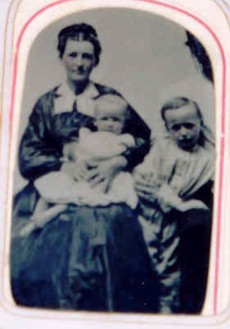 |
Interestingly, W. R. is not listed as a charter member of the Calhoun Presbyterian Church, organized in 1874, even though Mrs. W. R. Rankin Sr. is listed. However, all the names of family members appear in Pitts’ listing of early members taken from the Old Register. [Bell p. 222-3] She also includes W. R. among the church elders.
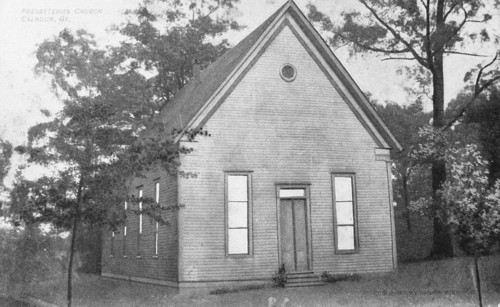
Calhoun Presbyterian Church, founded 1874. Photo taken about 1900
This partially corroborates the story passed down from grandson Harry Starr Jr.: W. R. was a member in good standing of the Baptist Church in Calhoun while the other members of his family attended the Presbyterian Church. One Sunday W. R., along with two or three others, were charged by the church elders to investigate the rumor a fellow church member was making moonshine. They were instructed to report back at the evening service. The committee made their way to the member’s house and announced their reason for the visit. Their host poured drinks all around, inviting them to decide for themselves if it were moonshine or not. One sip led to two; two sips led to four; it was a difficult decision requiring much study. One glass led to another and by evening the inebriated committee members and their afternoon host were no longer members in good standing of that particular Baptist Church.

From a Tintype: W. R. Rankin on left.
W. R. was elected to serve as a Municipal Officer for Calhoun in 1876 and continued to serve on this council off and on for several years. [Bell p. 286-7] In 1877 he was elected to serve as one of three members on the Board of Education and was elected president of the board in 1879. [Ibid p. 91; 110] In a serendipitous coincidence for some of his descendants, his fellow board member, J. H. Starr, was a distant cousin of W. R.’s future son-in-law.
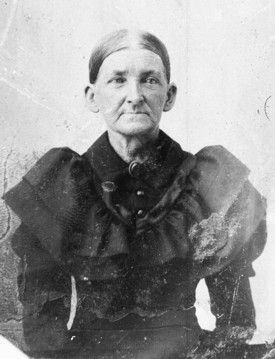
From a Tintype.
According to the 1880 census report, the population of Calhoun was 513. Seven of those citizens were inhabitants of W. R. and Maggie’s household. Besides the parents, the family then included: Willie R. age 12; Allie A age 8; Maggie I. age 6; Pauline O. age 3 and Rankin age 3 months. The baby’s name was George Reid; and Mary Belle completed the family circle in 1883. According to Lulie Pitts, Calhoun’s residents carried lanterns when walking along the streets at night so as to avoid the animals who were allowed free reign. Entertainment consisted of railway excursions and buggy rides, dances, debating and literary clubs, parties and picnics. For Maggie, those railway excursions went all the way back to South Carolina. This undated photo was taken during a reunion of the RAMSAY siblings.
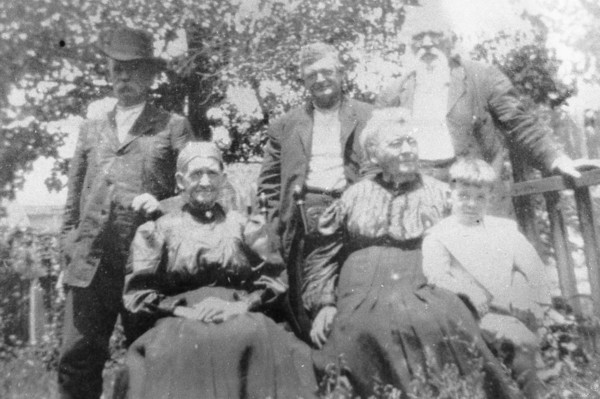
Without a doubt, politics would rank high on W. R.’s personal list of avocations. He was first elected to represent Gordon County at the State Assembly in Atlanta in 1875 and then again for the 1880-1883 terms. He was Speaker Pro Tem during the 1882-1883 session. A parting gift was this engraved silver urn or samovar. The engraving reads: To the Speaker Pro Tem Hon. Wm R. Rankin from the House of Representatives 1882-1883.
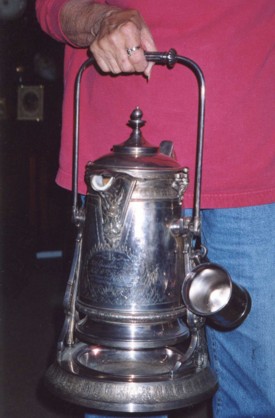
W. R. was then elected to the State Senate in 1884. [Bell p. 84] He is noted as the author and major sponsor of the first bill authorizing a Railroad Commission for Georgia. In 1886 W. R. was admitted as "Proctor and Advocate" to the Fifth Circuit Court of the United States for the Northern District of Georgia. The voters returned him to the House of Representatives for the 1888-1889 and then the 1892-1894 terms.
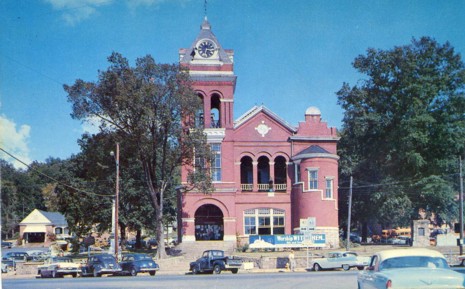
Gordon County Courthouse erected 1889.
In 1889 a brick pavement was laid in the business section of Calhoun and gasoline lamps were installed along the streets. Also, the new courthouse was completed at a cost of $14,400. Using his legal skills and political contacts in 1891, W. R. is credited with helping incorporate the Bank of Calhoun. [Bell p. 280] In the 1960s The Calhoun Times ran a series of articles written by Jewell B. Reeve titled "The year xxx" In the column headed for the year 1893: "Beautiful and substantial, the new bank building stands, up in Attorney’s Row. Built of pressed brick, with iron columns in a glass front, it is handsome and dashy in appearance. The building is owned by Hon. W. R. Rankin, the Bank of Calhoun, and Dr. J. H. Malone."
In the fall of 1895 W. R. announced as a candidate for the 7th Congressional District, U. S. Congress. One newspaper covering the announcement described Rankin as: "one of the strongest men in Gordon County ... a fine orator, splendid organizer and natural born leader." [Atlanta Constitution 8 Nov 1895] What made the announcement so newsworthy was, at the time, his opponent Judge John W. Maddox, "has not yet begun to serve the term for which he was elected and will not until the first Monday in next month." [Chattooga News, 13 Nov 1895] W. R.’s official announcement as a candidate for this office came 2 April 1896. He ran a good race, but lost the Congressional seat. Meanwhile his seat in the state assembly was taken by Oliver Newton Starr, son of the above mentioned J. H. Starr.
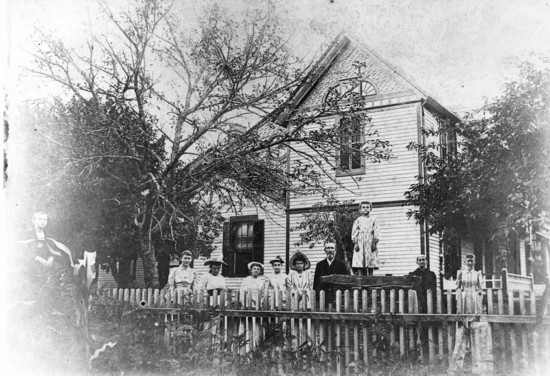
This group photo is one of the few made of the family; even so it leaves out William Jr. We can date it after 1893, the year this house was built, and before 1898, the marriage of their daughter Margaret in February that year. Beginning at the far left: George, Pauline, next three unknown, (daughter) Margaret, W. R., Mary Belle, Margaret (Ramsay) and Allie.
Within ten years they moved into the Rankin House near the train depot, to be nearer another of W. R.’s endeavors. He purchased the Rooker Hotel, built in 1885, and renamed it the Rankin House. Located very near the railroad tracks, it offered room and board for travelers. According to Ann Jones, the reason they moved "just down the hill" was to save commuting time and expense. She explained horses were expensive and it took time to saddle and unsaddle them each day.
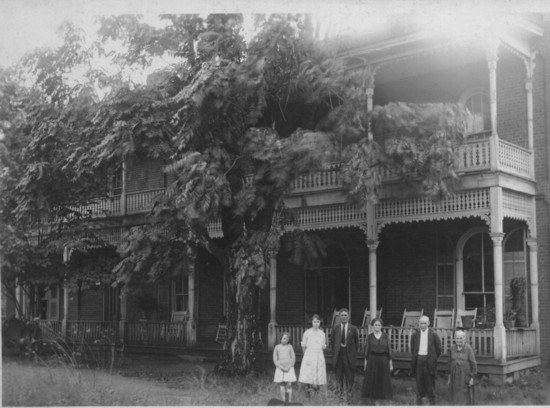
The next generation of Rankins began appearing in and around Calhoun in the 1890s.
J. B. F. Harrell, future husband of Allie, was named chairman of the (Calhoun) Municipal Officers in 1893, the same year W. R. was chosen as clerk. In 1894 daughter Maggie graduated from the Calhoun Collegiate Institute. In a confusing change of names, the previous Calhoun Times merged with The Brobdignagian Yahoo, becoming The Gordon Citizen in 1894. [Bell p. 203] That same year Proprietor W. R. Rankin Jr. published an independent paper under the name The Calhoun Times. Then in January 1896 The Gordon Citizen and The Calhoun Times were consolidated under new ownership and the name became The Calhoun Times. In 1898 G. R. Rankin, younger son of W. R., is listed as a volunteer member of the first fire company in Calhoun. Called the Vigilant Fire Company #1, the equipment consisted of a hose operated by a hand reel. [Bell p. 279] That same year Miss Mamie Rankin gave a recitation to the Literary Society.
In 1898 W. R. was again elected to the Municipal Officers of Calhoun and is listed as Clerk of this group in 1899. As such his salary was "not to exceed sixty dollars a year." His name appears on the list of the Oothcaloga Lodge No. 154 of Free and Accepted Masons (between 1856 and 1933). [Bell p. 204] Although all his children had graduated by this time, W. R. was elected president of the Board of Education in October 1901 with O. N. Starr the vice-president. W. R. ended his political career by representing Gordon County from 1902-1904. From the State House he moved into banking. The People’s Bank of Calhoun was incorporated in 1905 by W. R. Rankin Sr., J. B. F. Harrell (future husband of Allie Rankin) and others. W. R. is listed as cashier and both men appear among the group of Bank Directors. First organized as a private bank, it became a state bank only eight months later. [Bell p. 281]
Mamie (Rankin) Norton is listed as a charter member and past president of the Gordon County chapter of the United Daughters of the Confederacy. Organized June 1905, "The object of the organization is to keep alive the traditions of the old South, and to honor Confederate veterans of the War Between the States, both living and dead." [Bell p. 207] W. R. was among the first to be honored by the group. Maggie was similarly honored by the Calhoun Woman’s Club (founded in 1902.)
Granddaughter Alice (Starr) Schisler had fond memories of her grandpa Rankin dating back to the first decade of the 20th century. Even though she was only five in 1906 when the Starrs left for Oklahoma the first time, she, her mother and siblings made one trip back to Calhoun. Alice enjoying repeating her memories of these grandparents and notes were taken during the course of several visits with her. She remembered
1906:
|
|
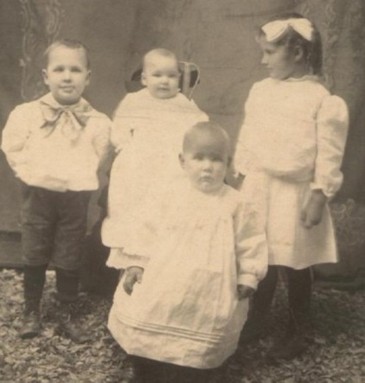 |
| Margaret, daughters Mamie and Alllie, granddaughter Pauline Estelle | Grandchildren: William, Pauline Estelle, Harry Jr. and Alice |
proudly watching her grandpa "giving an oratory" on the court house steps. She added, "the Rankins always had strong opinions about things." In the evenings the family would sit in a semi-circle around the fireplace. Some would read while others talked or just listened. W. R. would idly stroke his beard while reading. The room was filled with books. She said one always knew where her grandmother was for her shoes squeaked. W. R. took Alice and her brother(s) to their first movie. She reported her grandmother was a good letter writer, something the family in Oklahoma especially appreciated. Alice retained for seventy-seven years the last two letters from her grandmother. The penmanship is remarkable for a woman then in her eighties! Alice described W. R. as full of mischief and said he sure liked to tease the kids. But, she quickly added, people respected him for good reason. One of her fondest reminisces was W. R.’s gift of a drinking cup. He handed it to her as she got in line to board the train for Oklahoma. This cherished heirloom was passed to a grand niece within the last two years of Alice’s life.
Presumably the last time W. R. and Maggie saw the ones who had moved west -- Pauline and George and their families -- was the summer of 1911. Alice told W. R. and Maggie made one visit to Oklahoma. It is not unreasonable to assume W. R. attended the large gathering of veterans (both North and South) in Little Rock, Arkansas that year. Indeed, it is difficult to imagine him NOT attending such a gathering. From Little Rock it was a short train ride to southeastern Oklahoma / northeast Texas where Pauline and George R. and their families lived at the time. W. R. and Maggie may even have made a side trip to visit W. R.’s siblings in north Texas.
In 1908 W. R. was elected Judge of the Court of Ordinary (i..e., probate court) for Gordon County. At the special election to replace the deceased W. R. Sr., his son, W. R. Jr., was elected to the position and remained in that office until his own death. [Bell p. 86]
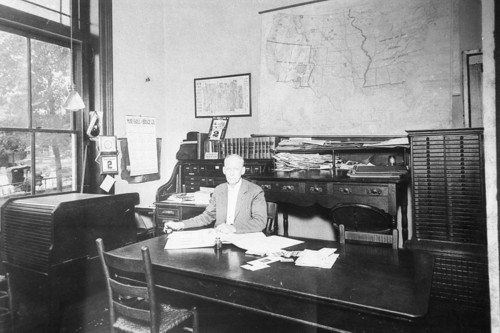
W. R. Jr., seated at the desk formerly used by his father.
One of W. R.’s pet projects when serving in the Atlanta Assembly was the creation of the Dixie Highway. The highway arrived in Calhoun in 1917. During the Christmas season of 1912-1913 W. R. sent his personal greetings to friends and relatives. This post card sent to his daughter Pauline’s family was among the treasured items found in their family papers.
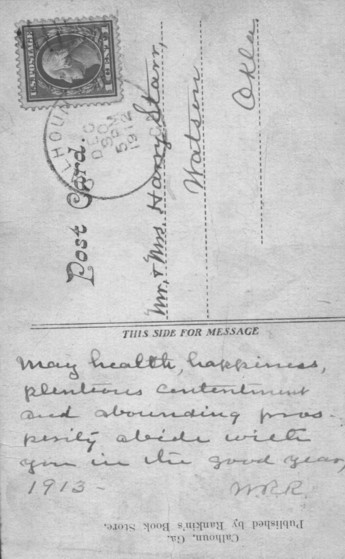
William Robertson Rankin died of peritonitis from a ruptured appendix [Schisler] 5 June 1913. Margaret Jane (Ramsay) died 15 October 1923 "probably from skin cancer (she had lesions on her face) and effects of osteoporosis. "
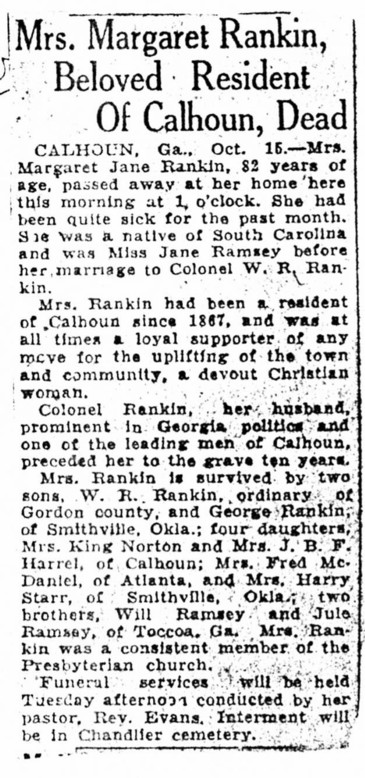
They are buried in the Rankin plot in the Chandler Cemetery atop the hill in Calhoun, Georgia. The pictures below show the large monument for the family plot, and the footstones for W. R. and Margaaret:
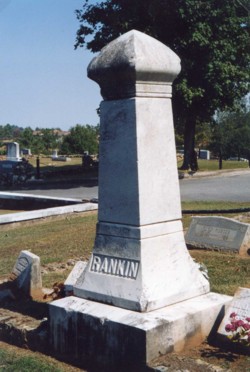
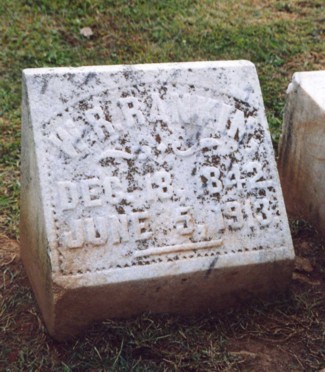

An early 20th century custom was sending eulogies to the editor of the local paper when someone one wanted to honor, died. Several eulogies were printed for W. R. One, written by A. L. Henson, was published under the headline "Stories I have Heard": "Rankin was most positive in any position which he took, and in every local or state-wide controversy, he led one side or the other. If he chanced to see a couple of chickens in a barn-yard fight he would take sides with one of them. He was never neutral. And in every political race he would vigorously support one of the candidates." Another, written by M. W. Gross of Hugo, Oklahoma was addressed to G. R. Rankin: "I have just read in the daily Atlanta Constitution of ... the death of your distinguished father ... while I am not acquainted with you ... Your father and I served in the Georgia legislature together .... I had no better friend in the house of 1904 than your beloved father; and there was no nobler truer man ever served a people than Hon. W. R. Rankin." Another eulogy, this one from H. C. Hunt, describes Maggie as "a woman of rare strength of character and deep religious nature. Their married life was sanctified by love of God, and made happy by a constant devotion to each other."
W. R. and Margaret (Ramsay) had seven children, six surviving to adulthood:
William Robertson Rankin Jr. born 4 May 1868 died 13 July 1934, Calhoun, Georgia unmarried.
Sallie Rankin born 17 March 1870 died 20 August 1870 Calhoun, Georgia. Buried in the Rankin plot at the Chandler Cemetery.
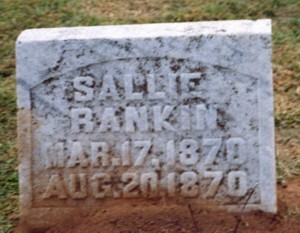
Allie Anna Rankin born 3 February 1872 died 27 August 1950 Calhoun, Georgia married J. B. F. Harrell 23 September 1918.
Margaret Irene "Maggie" Rankin born 10 April 1874 died 20 Augusta 1964 Atlanta, Georgia. She married Fred McDaniel February 1898.
Pauline Olivia Rankin born 25 March 1877 Calhoun, Georgia died 29 January 1966 Mena, Arkansas. She married Harry Starr 21 November 1900 at 3:30 p.m. in her parents home.
George Reid Rankin born 24 February 1880 Calhoun, Georgia died 28 April 1932 Paris, Texas. He married 1st Hallie Ford 9 January 1900; married 2nd Fauna Mae Beauchamp 24 November 1908, Antlers, Oklahoma.
Mary Belle "Mamie" Rankin born 29 May 1883 died 1 June 1963 Calhoun, Georgia. She married 17 September 1905 King Norton.
SOURCES
Bell, Burton J., compiler and editor. 1976 Bicentennial History of Gordon County Georgia. Gordon Co. Historical Society, Calhoun, 1976 Includes the history written by Pitts. My original notes were taken from Pitts, but I cite page numbers from the Bell work. Neither work is indexed.
Brown, John M. compiler. Yesteryears: Pictorial History of Calhoun and Gordon County, Georgia 1830-1977 Gordon County Historical Society, Calhoun 1977
Centre College Catalogue 1861
Chandler, L. D., Ramsay family researcher.
Jones, Dr. Ann Norton, descendant with access to W. R.’s family papers, pictures and Bible.
Newspaper article titled Col. W. R. Rankin: A Sketch of His Life and Public Services. The specific name of paper, date and other citation notes were not included by the person who originally clipped this from the paper. The sketch is presumed to be from one of the Atlanta papers, and was perhaps published at the time of his death.
Pitts, Lulie, author. History of Gordon County Georgia 1934
Ramsay, Elizabeth E., compiler. Links I & II: Ramsey & Allied Families
Reeve, Jewell B., compiler. Climb the Hills of Gordon, Southern Historical Press, Easley, SC 1979
Schisler, Alice Starr, granddaughter.
Starr, Linda Sparks, author. W. R. Rankin: Manassas to Appomattox 1990.
Wigington, Jo Ann (Rankin), researcher, author of sketches about Slabtown appearing in various histories of the area.
Home: http://homepages.rootsweb.ancestry.com/~lksstarr/
Linda Sparks Starr copyright (c) 2010